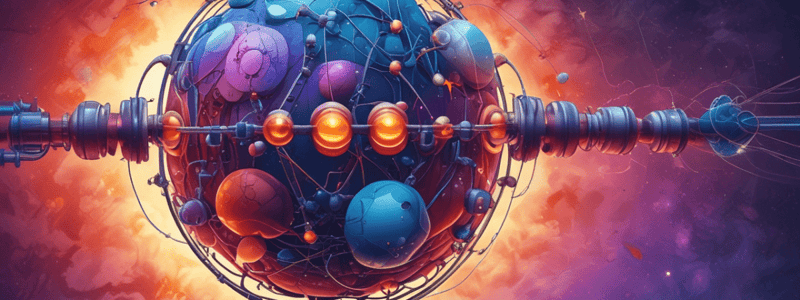Podcast
Questions and Answers
What is the characteristic of particles in an ideal gas?
What is the characteristic of particles in an ideal gas?
- They have no mass and occupy no volume
- They have a definite volume
- They have both mass and volume
- They have a mass but occupy no volume (correct)
What is the unit of measurement for the number of particles in a gas?
What is the unit of measurement for the number of particles in a gas?
- Cubic meters
- Kelvins
- Liters
- Moles (correct)
What is the temperature scale used by scientists for calculations?
What is the temperature scale used by scientists for calculations?
- Fahrenheit
- Rankine
- Degrees Celsius
- Kelvins (correct)
What is the force exerted by gas particles on the container walls?
What is the force exerted by gas particles on the container walls?
What is the accepted SI unit for gas pressure?
What is the accepted SI unit for gas pressure?
What is the definition of pressure?
What is the definition of pressure?
What happens to the volume available to the gas when more gas particles are added to the cylinder?
What happens to the volume available to the gas when more gas particles are added to the cylinder?
Why does the piston rise when more gas particles are added to the cylinder?
Why does the piston rise when more gas particles are added to the cylinder?
What is the relationship between the number of gas particles and volume according to Avogadro's Law?
What is the relationship between the number of gas particles and volume according to Avogadro's Law?
What happens to the internal pressure when the piston rises?
What happens to the internal pressure when the piston rises?
What happens to the pressure of a gas when its volume is decreased, while keeping the temperature and number of gas particles constant?
What happens to the pressure of a gas when its volume is decreased, while keeping the temperature and number of gas particles constant?
Why does the volume of your lungs increase when you breathe in?
Why does the volume of your lungs increase when you breathe in?
What is the relationship between the pressure and volume of an ideal gas, if the temperature and number of gas particles are constant?
What is the relationship between the pressure and volume of an ideal gas, if the temperature and number of gas particles are constant?
What is the purpose of the valve on the left of the apparatus?
What is the purpose of the valve on the left of the apparatus?
What happens to the pressure of a gas when its volume is doubled, while keeping the temperature and number of gas particles constant?
What happens to the pressure of a gas when its volume is doubled, while keeping the temperature and number of gas particles constant?
What is the statement that describes the inverse relationship between the pressure and volume of an ideal gas?
What is the statement that describes the inverse relationship between the pressure and volume of an ideal gas?
What happens to the volume of a gas when its pressure is increased, while keeping the temperature and number of gas particles constant?
What happens to the volume of a gas when its pressure is increased, while keeping the temperature and number of gas particles constant?
Do real gases follow the exact mathematical relationship between pressure and volume described by Boyle's Law?
Do real gases follow the exact mathematical relationship between pressure and volume described by Boyle's Law?
Which equation is commonly memorized and written?
Which equation is commonly memorized and written?
What is the purpose of rearranging the ideal gas equation to isolate R?
What is the purpose of rearranging the ideal gas equation to isolate R?
What does the ratio PV/nT always remain the same for?
What does the ratio PV/nT always remain the same for?
What is the purpose of the expanded form of the ideal gas equation?
What is the purpose of the expanded form of the ideal gas equation?
What are the units of the standard gas containers used to fill luminous tubes?
What are the units of the standard gas containers used to fill luminous tubes?
At what temperature and pressure are the standard gas containers filled?
At what temperature and pressure are the standard gas containers filled?
What is the initial pressure of the gas in the standard container?
What is the initial pressure of the gas in the standard container?
What is the final volume of the gas when it exerts a pressure of 1.3 kPa at 19 °C?
What is the final volume of the gas when it exerts a pressure of 1.3 kPa at 19 °C?
Which law can be used to find the final volume of the balloon when the pressure is reduced from 3 atmospheres to 0.5 atmospheres?
Which law can be used to find the final volume of the balloon when the pressure is reduced from 3 atmospheres to 0.5 atmospheres?
What is the final volume of the balloon when the pressure is reduced from 3 atmospheres to 0.5 atmospheres?
What is the final volume of the balloon when the pressure is reduced from 3 atmospheres to 0.5 atmospheres?
What is the volume of the gas when it is compressed from 2.00 L to 1.00 L?
What is the volume of the gas when it is compressed from 2.00 L to 1.00 L?
What is the purpose of converting the temperature from Celsius to Kelvin in the problem?
What is the purpose of converting the temperature from Celsius to Kelvin in the problem?
The ideal gas equation is often written in the form PV = nRT.
The ideal gas equation is often written in the form PV = nRT.
The ratio of PV/nT always changes when the properties of an ideal gas change.
The ratio of PV/nT always changes when the properties of an ideal gas change.
The expanded form of the ideal gas equation uses moles (n) instead of mass in grams (g) divided by molar mass (M).
The expanded form of the ideal gas equation uses moles (n) instead of mass in grams (g) divided by molar mass (M).
The standard gas containers used to fill luminous tubes have a volume of 2.0 L.
The standard gas containers used to fill luminous tubes have a volume of 2.0 L.
Neon gas in luminous tubes radiates blue light.
Neon gas in luminous tubes radiates blue light.
R is a constant that varies depending on the pressure unit used.
R is a constant that varies depending on the pressure unit used.
The ideal gas equation is derived from the equation of state for real gases.
The ideal gas equation is derived from the equation of state for real gases.
The ideal gas equation can be used to calculate changes in the properties of a real gas.
The ideal gas equation can be used to calculate changes in the properties of a real gas.
The temperature of the neon gas in the standard containers is 20 °C.
The temperature of the neon gas in the standard containers is 20 °C.
The pressure of the neon gas in the standard containers is 100 kPa.
The pressure of the neon gas in the standard containers is 100 kPa.
Flashcards are hidden until you start studying





